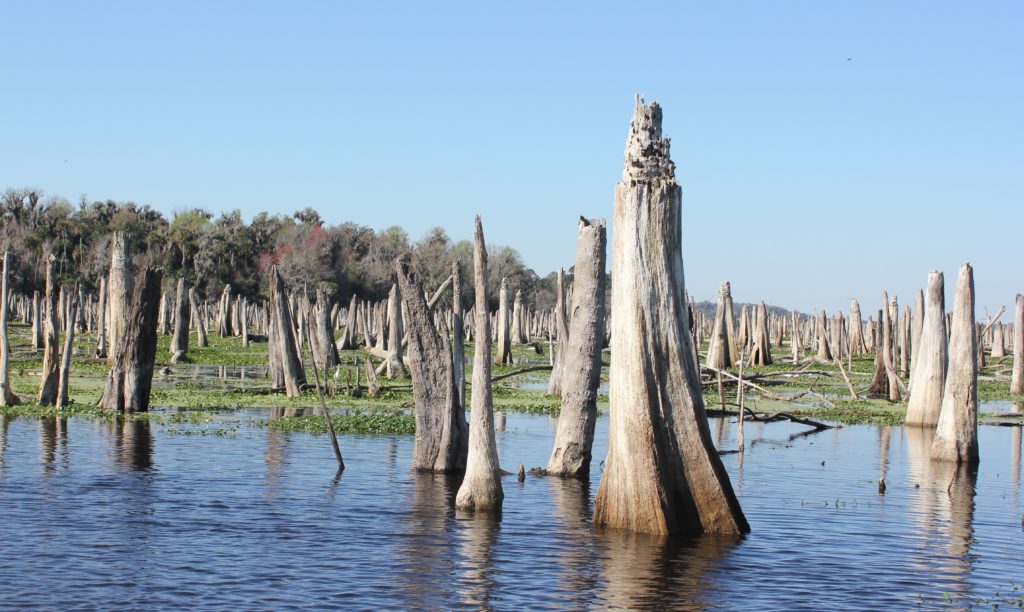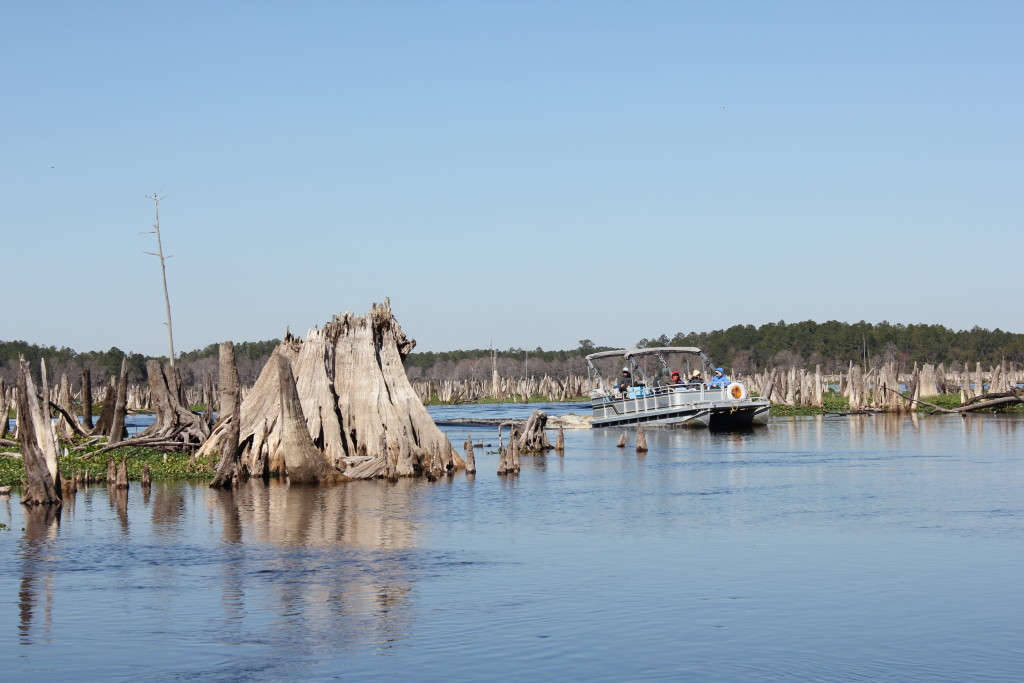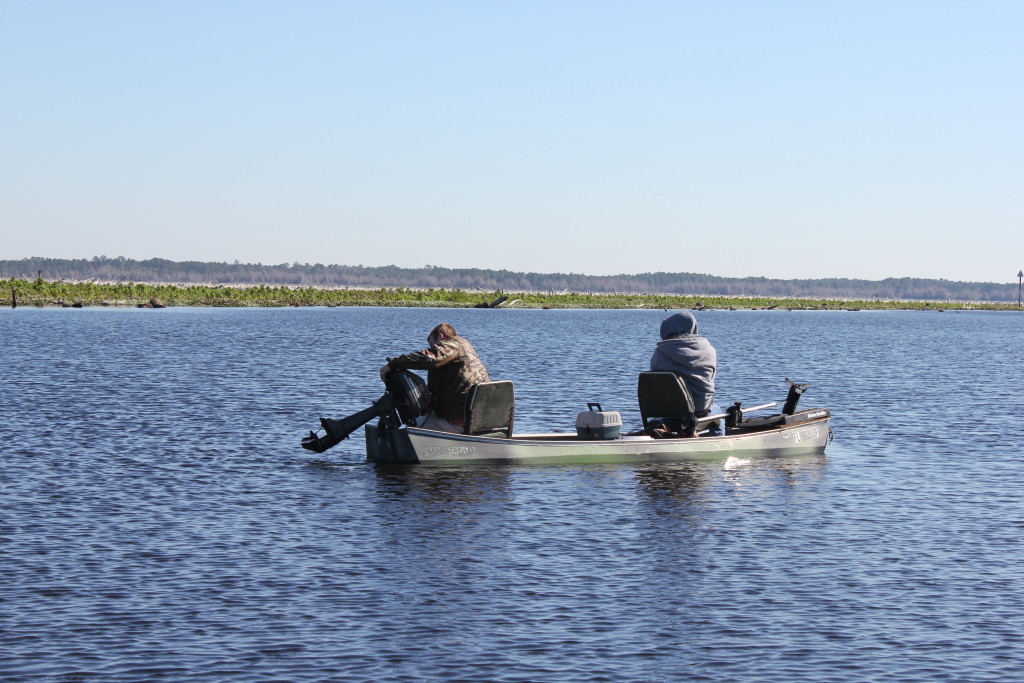
Near Palatka, FL — Water at the Rodman Dam will rise again starting today, when the locks are shut after a five month drawdown to clean out choked-up, rotting vegetation.
Closing the dam will stop the historic Ocklawaha River from emptying freely into the St. Johns River and will flood around 15,000 acres of forested land, former family home sites, archeological sites, and springs. Built in the 1960s as part of a federal project that was scrapped, the dam created a large lake that some in the community have come to value for fishing, tourism and wildlife, while others call for restoration of the original river.
Some call the manmade water body Rodman Reservoir, some call it Rodman Pool, some call it Lake Ocklawaha, but by any name it became a favorite of bass fishermen, although not the historic bass that once swam in the river. Striped bass used to swim up the Ocklawaha from the St. Johns to spawn, but the dam has stopped their migration, just as it has prevented manatees from seeking out the warm spring water when the St. Johns turns chilly in the winter. As the manatee population in Florida continues to rise from near-extinction in the 1970s to a proposed delisting from “Endangered” just this year, there may be more calls to restore original habitat by removing the dam.
The bass that make the pool popular among today’s fishermen are large-mouth bass, which are numerous enough and big enough to draw tournaments and anglers from all over the world in years past. Trees from the flooded forest broke off at water height after the dam was built, leaving a jagged snaggle of stumps underwater, which makes excellent habitat for bass to hide and grow trophy-sized. It’s the fishing and tournaments that some say are enough reason to leave the dam alone in Putnam County, one of Florida’s poorest counties.
The remnants of the old forest are visible during the drawdown when the pool is lowered at least five feet to nearer the original elevation of the land. The narrow, meandering, ancient Ocklawaha takes up its old route surrounded by stumps of cypress, oak, pine and palmetto that haven’t yet rotted out in their four decades underwater. One local guide calls it a “tree cemetery.”

The Ocklawaha River is as old as Florida itself.
Fossils from armadillos the size of brown bears have been found along its banks, as well as pottery and arrowheads thousands of years old. The river was formed by a long-ago earthquake which shifted the south bank upward, creating a steep embankment and exposing what had been underground springs.
There are about 20 springs that historically fed the river with fresh water from the Floridan Aquifer prior to the dam. Pressure from the lake stops up the springs, but they bubble back up during the drawdown. Kayakers and divers come to see the springs during drawdown, but some locals say the waters aren’t as clear as they were. They say the aquamarine colors found in most healthy springs and in the memories of childhood swimmers are gone.
Archaeologists interested in the Ocklawaha’s historic banks have conducted digs during the drawdown, which only occurs about every three years. When the dam was built, it was estimated the state would have to release the water about every ten years to clean out accumulated debris, but it’s ended up being about every three years.
In between, the state sprays herbicide on the pool regularly and does more extensive clean out every few years at a cost of around $2 million. It then restocks the pool with bass and the cycle starts again.
The river is fed by Silver Springs in Ocala, one of the state’s oldest and fastest-pumping springs, which feeds into the Silver River and then into the Ocklawaha.
It’s that pure spring flow some opponents of the dam would like to see restored. Prior to the dam, the vegetation didn’t back up. The water flowed directly into the St. Johns River as one of its three largest tributaries, providing it with much-needed fresh water.
But others in the county say that nature has adjusted to the pool created by the dam and should be left alone. They say it’s a sportsman’s haven for hunting, wildlife viewing and fishing.
There’s been plenty of wildlife viewing during the drawdown, according to local eco-tour guides who say birding is better during the drawdown because the exposed stumps provide landing spots and birders can see them up close. The guides also say there’s more embankment to fish from, which can’t be done when the lake is up.

Politics have kept the dam in place, and there’s a long history of that, too.
Almost 175 years ago, a deal was struck between the Seminole Indians and the federal government upstream at Payne’s Landing. The government wanted the land in the center of the state back that it had given to the Seminoles under the Treaty of Moultrie Creek. So under the 1832 Treaty of Payne’s Landing, the feds paid the Seminoles and gave them three years to move to a reservation in Arkansas. What exactly the agreement was is unclear because it wasn’t recorded, but the Indians took the payment and bought guns and powder for the battle that was to come. Under new chiefs like Micanopy and Osceola, the Second Seminole War had begun.
Today the federal government wants no part of the dam battle. The dam sits on federal forest land and the permit to operate it hasn’t been renewed in years. Numerous studies have been done by scientists and even the state’s regulatory agency, the Florida Department of Environmental Protection, recommending its removal.
But state legislators have refused to act year after year, administration after administration, recently approving money for another study at the request of local commissioners.
It will take about three weeks for the pool to fill again. Migratory birds, like the White Pelican, will have headed north. Gators will come out of their lair into the warm sun. Bass boats will line up at the boat ramp.
And the eastern end of the ancient Ocklawaha River will be buried once more, waiting for the next chapter in its long and winding history.

